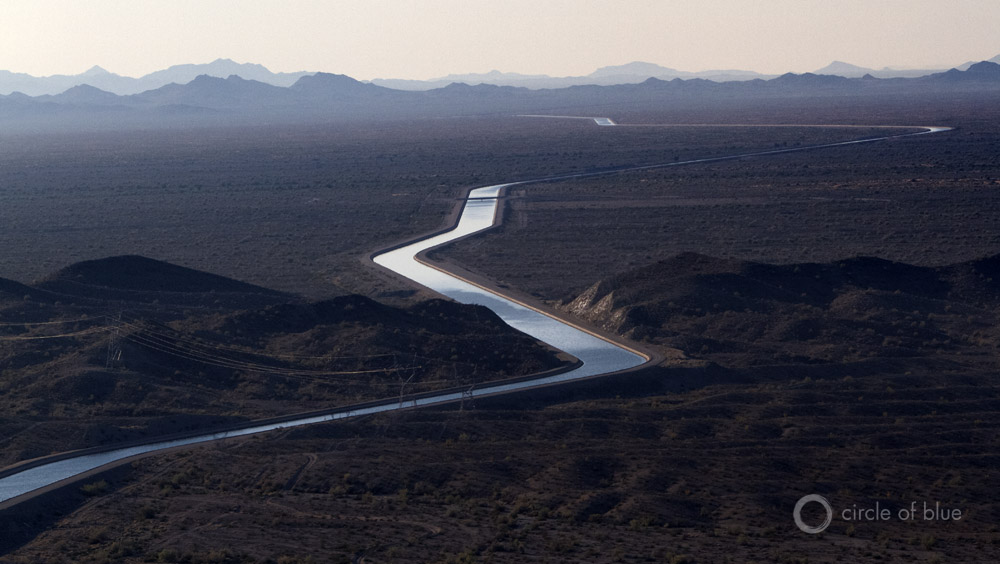California Groundwater Regulation Hangs on a Few Words
As a key deadline approaches, a debate over word choice.

Water is pumped from a groundwater well for farm irrigation in Kern County, California. Photo © J. Carl Ganter / Circle of Blue
By Brett Walton, Circle of Blue
It was never going to be easy.
California’s attempt to exert tighter control over groundwater use, the purpose of a landmark 2014 state law, was designed to be a compromise between state authority and local oversight.
The tension dogged the writing of the law two years ago, and is playing out again as the California Department of Water Resources (DWR) drafts the regulations that will put the law into practice.
The regulations in question are those that the state will use to evaluate groundwater sustainability plans, the 20-year planning documents required of local management agencies by the 2014 law. The debate today hinges on a single word repeated throughout the 62-page draft regulations. That word is “substantial,” used in phrases such as “substantial compliance” with the rules.
Opinions are divided. Legal scholars, scientific watchdogs, and environmental groups, some befuddled by its inclusion, argue that “substantial” weakens the law by allowing local agencies to avoid all of the mandates for data sharing, monitoring, land use, oversight, and others.
It’s going to be critical that this is successful for not only groundwater but for the entire water management of the state of California.”–David Gutierrez, California Department of Water Resources
Water agencies and farm lobbies, advocates of greater local control, and other legal experts say that the phrasing acknowledges the diversity of California’s groundwater basins. Not all local agencies have the same technical or financial capacity. Management actions will evolve, say advocates of “substantial,” in response to changing hydrological conditions. Not all provisions are equally urgent or necessary for all areas, they assert.
The Department of Water Resources argues that the language allows for flexibility within basins while retaining the mandate that groundwater be managed sustainably.
“This doesn’t mean that agencies can omit sections or articles of the regulation and hope that we’re going to deem it an adequate plan,” said DWR’s Trevor Joseph at an April 20 meeting of the California Water Commission. “We reserve the right to determine what is substantially compliant, not the local agency.”
But members of the California Water Commission find the substantial compliance language confusing and unnecessary. Five of the eight members said so at the April 20 meeting and asked for its removal.
“It seems to me that it’s a second-tier evaluation,” said Maria Herrera, a commission member. “It gives the department a lot of discretion and doesn’t make it very clear to me or the public what the department will use to deem a plan adequate or not.”
“Substantial is a qualifying word and I think it creates confusion, so I would ask that we consider saying compliance,” said Armando Quintero, another commission member.
Decisions on the language will be made soon. The DWR will submit final regulations to the California Water Commission to review before the May 18 meeting. The regulations will be adopted by June 1.
“It’s going to be critical that this is successful for not only groundwater but for the entire water management of the state of California,” said David Gutierrez, DWR’s chief of sustainable groundwater management implementation.
A First Attempt at Groundwater Regulation
On September 16, 2014, Gov. Jerry Brown signed into law the Sustainable Groundwater Management Act, a trio of bills that sought to accomplish what California, unlike its neighbors, had never done — develop statewide standards for regulating groundwater use.
The bill set in motion a cascade of deadlines. Local governments must form a groundwater management agency by June 30, 2017, and then develop a plan for managing the resources, due by 2020 or 2022 depending on the severity of the area’s groundwater decline. The state, for its part, had to define the boundaries of the basins and write the rules for evaluating the management plans.
The draft regulations, posted in February, drew hundreds of comments with roughly two thousand recommended changes. The “substantial” compliance language resurrected the familiar debates of local versus state control, and basin-by-basin flexibility versus state-ordered prescriptions for plan content and approval.
The California Farm Bureau Federation, the voice of big agriculture, and the Association of California Water Agencies, which largely represents municipal interests, support the substantial compliance standard, arguing that it is appropriate for a state with such hydrological and institutional variety among its 515 groundwater basins.
The regulations matter. California is home to nine of the country’s top 10 farm counties by sales. The state’s $US 54 billion agricultural economy produces all the almonds, raisins, walnuts, pomegranates, pistachios, and artichokes that are grown in the United States. How the groundwater law is implemented will determine how much water is available to one of the world’s most bountiful farming belts and how resilient the region’s farms, towns, and industries will be to future water scarcity.
The regulations matter for reasons other than agriculture, too. They are intended to avoid six “undesirable results” that were spelled out in the law: land subsidence, saltwater intrusion into freshwater aquifers, a loss of aquifer storage capacity, a decline in groundwater levels, polluted groundwater, and depletion of river flows or springs.
The Nature Conservancy and a coalition of 20 environmental, tribal, and clean water groups object to the use of substantial compliance. “The term substantial compliance is unclear and it makes the standard for evaluation less precise and more subjective,” wrote Sandi Matsumoto and Jay Ziegler of The Nature Conservancy in comments submitted to DWR.
Juliet Christian-Smith, a climate scientist at the Union of Concerned Scientists, one of the coalition groups, says that the regulatory language is at odds with the intent of the act, which is based on achieving measurable goals.
“In this case, there is no A for effort,” Christian-Smith told Circle of Blue. “Either you stop the groundwater decline or you don’t. The point of the act is to move away from a soft approach to a data-based, scientific approach.”
Dave Owen, a professor at the University of California Hastings College of the Law, said that the draft language invites the possibility that the DWR could accept plans that include most, but not all of the requirements.
“Local agencies will have to make tough choices that are politically difficult” when they write their plans, Owen told Circle of Blue. Limits, restrictions, and poking into what once was personal business are never an easy sell. “There’s the potential for slippage, for plans that aren’t restrictive, with the hope that DWR will let them slip through,” Owen said.
Owen and two colleagues submitted comments to the DWR that expressed their concern that the word choice undermines the act.
Other legal experts are more sympathetic to the difficulty of implementation.
Eric Garner, a lawyer with Best, Best and Krieger and author of the legal text California Water, said that the lack of groundwater data, compared to surface water data, makes the management effort much more difficult than for rivers or streams.
“There’s going to be trial and error in this process,” Garner told Circle of Blue. “There are going to be issues with the plans. There have to be adjustments. Substantial compliance is a recognition that there is not a simple recipe to get every basin to sustainability.”
Brett writes about agriculture, energy, infrastructure, and the politics and economics of water in the United States. He also writes the Federal Water Tap, Circle of Blue’s weekly digest of U.S. government water news. He is the winner of two Society of Environmental Journalists reporting awards, one of the top honors in American environmental journalism: first place for explanatory reporting for a series on septic system pollution in the United States(2016) and third place for beat reporting in a small market (2014). He received the Sierra Club’s Distinguished Service Award in 2018. Brett lives in Seattle, where he hikes the mountains and bakes pies. Contact Brett Walton













Leave a Reply
Want to join the discussion?Feel free to contribute!